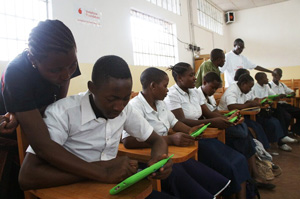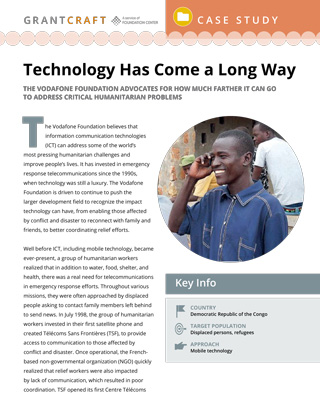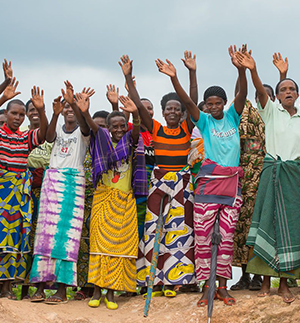Technology Has Come a Long Way The Vodafone Foundation Advocates for How Much Farther it can go to Address Critical Humanitarian Problems
The Vodafone Foundation believes that information communication technologies (ICT) can address some of the world’s most pressing humanitarian challenges and improve people’s lives. It has invested in emergency response telecommunications since the 1990s, when technology was still a luxury. The Vodafone Foundation is driven to continue to push the larger development field to recognize the impact technology can have, from enabling those affected by conflict and disaster to reconnect with family and friends, to better coordinating relief efforts.
Well before ICT, including mobile technology, became ever-present, a group of humanitarian workers realized that in addition to water, food, shelter, and health, there was a real need for telecommunications in emergency response efforts. Throughout various missions, they were often approached by displaced people asking to contact family members left behind to send news. In July 1998, the group of humanitarian workers invested in their first satellite phone and created Télécoms Sans Frontières (TSF), to provide access to communication to those affected by conflict and disaster. Once operational, the French-based non-governmental organization (NGO) quickly realized that relief workers were also impacted by lack of communication, which resulted in poor coordination. TSF opened its first Centre Télécoms (telecommunications center) in 2001 in northern Afghanistan to support humanitarian efforts.
Food and shelter remain paramount in the aftermath of a disaster; but there is a growing recognition of the role that technology can play in addressing certain challenges,” shares The Vodafone Foundation Instant Network Programme manager Oisin Walton. the Vodafone Foundation invests in the communities in which the London-based telecommunications company Vodafone operates, and has been funding TSF operations worldwide since 1998.
In addition to financial support, the Vodafone Foundation collaborated with TSF and global telecommunications solutions provider, Huawei, to create an ultra portable mobile network—called Instant Network—that fits in three suitcase-sized boxes and can be transported on commercial flights.
 Pushing the humanitarian field to appreciate the importance of ICT has become central to the Vodafone Foundation’s funding portfolio. The field has made some headway. For example, in 2007, the Emergency Telecommunications Cluster (ETC) was established by the United Nations (UN) to improve coordination and minimize gaps in emergency response. The UN established nine thematic clusters—Nutrition, Health, Water/ Sanitation, Emergency Shelter, Camp Coordination/ Management, Protection, Early Recovery, Logistics, and Emergency Telecommunications—to improve coordination in the field and at the global level. Each field-level cluster is led by a UN agency. The ETC has been activated in 25 countries to provide communications services and internet connectivity to assist humanitarian operations.
Pushing the humanitarian field to appreciate the importance of ICT has become central to the Vodafone Foundation’s funding portfolio. The field has made some headway. For example, in 2007, the Emergency Telecommunications Cluster (ETC) was established by the United Nations (UN) to improve coordination and minimize gaps in emergency response. The UN established nine thematic clusters—Nutrition, Health, Water/ Sanitation, Emergency Shelter, Camp Coordination/ Management, Protection, Early Recovery, Logistics, and Emergency Telecommunications—to improve coordination in the field and at the global level. Each field-level cluster is led by a UN agency. The ETC has been activated in 25 countries to provide communications services and internet connectivity to assist humanitarian operations.
The field still has a ways to go to truly prioritize communications in emergencies, as a necessity for victims and workers, and as a tool to deliver lifesaving interventions. Despite the establishment of the ETC, “access to communication and connectivity for victims of conflict and natural disaster don’t fall under any cluster,” shares Oisin. This pushed the Vodafone Foundation to develop the Instant Network Programme, to quickly provide ICT in the wake of an emergency to both victims and relief workers. “Telecommunications companies are getting involved in disaster response, alongside humanitarian relief workers, to get the networks up and running as quickly as possible. Companies increasingly play a role in relief efforts that goes beyond ensuring business continues, to help their clients and support relief efforts.”
The technology is changing faster than work practices. Even where technology is available, Oisin shares that sometimes aid workers don’t use it to its full potential. “That makes our job interesting in terms of finding solutions. The approach from the humanitarian community was historically to categorize technology as a luxury, saying ‘it’s a gadget, it’s nice to have,’ but thinking about the effectiveness of data collection on tablets, mobile networks in emergencies, and mobile phone-based money transfers, it’s clear that technology can actually address some of the challenges that NGOs and their beneficiaries face.” For the Vodafone Foundation, providing support to aid in adoption of practice and understanding is therefore an important part of how it approaches its work. Staff advocate with NGOs and in humanitarian coordination meetings for the benefits of using updated technology practices.
“Compared to years ago, when only aid agencies had access to communications via satellite phone and victims didn’t have anything, now agencies and victims use the same communications tools and mobile networks. This creates incredible potential to improve interventions. It enables two-way communications so that aid agencies can understand the needs on the ground directly from those affected.” For example, in the aftermath of the 2015 earthquake in Nepal, mobile networks enabled people to send messages and tweet, sharing updates before relief workers were deployed.
Oisin explains further: “When we look at how technology can solve some of the greatest development issues, a lot of our work remains in advocating with relevant stakeholders that the upfront investment in technology is worth the outcomes and impact. We find ourselves explaining that ‘yes you will have to adapt your work practices and it’s going to take a while to adjust, but in the long run, you’ll actually see the real benefits as well as the time it’s going to save you.’”
This case study was developed for Foundation Center's Equal Footing project.





